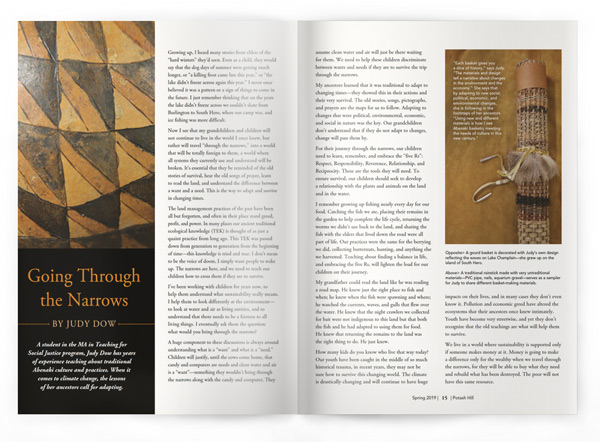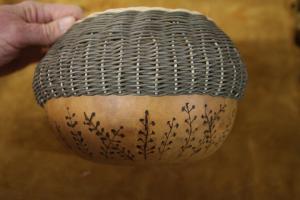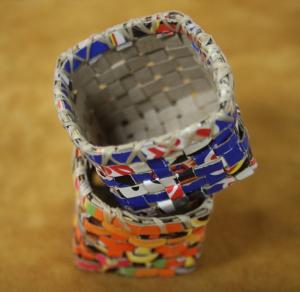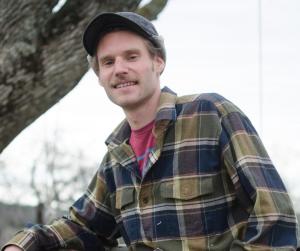Going Through the Narrows

By Judy Dow
A student in the MA in Teaching for Social Justice program, Judy Dow has years of experience teaching about traditional Abenaki culture and practices. When it comes to climate change, the lessons of her ancestors call for adapting.

Growing up, I heard many stories from elders of the “hard winters” they’d seen. Even as a child, they would say that the dog days of summer were getting much longer, or “a killing frost came late this year,” or “the lake didn’t freeze across again this year.” I never once believed it was a pattern or a sign of things to come in the future. I just remember thinking that on the years the lake didn’t freeze across we couldn’t skate from Burlington to South Hero, where our camp was, and ice fishing was more difficult.
Now I see that my grandchildren and children will not continue to live in the world I once knew, but rather will travel “through the narrows,” into a world that will be totally foreign to them, a world where all systems they currently use and understand will be broken. It’s essential that they be reminded of the old stories of survival, hear the old songs of prayer, learn to read the land, and understand the difference between a want and a need. This is the way to adapt and survive in changing times.
The land management practices of the past have been all but forgotten, and often in their place stand greed, profit, and power. In many places our ancient traditional ecological knowledge (TEK) is thought of as just a quaint practice from long ago. This TEK was passed down from generation to generation from the beginning of time—this knowledge is tried and true. I don’t mean to be the voice of doom, I simply want people to wake up. The narrows are here, and we need to teach our children how to cross them if they are to survive.
I’ve been working with children for years now, to help them understand what sustainability really means. I help them to look differently at the environment— to look at water and air as living entities, and to understand that there needs to be a fairness to all living things. I eventually ask them the question: what would you bring through the narrows?
A huge component to these discussions is always around understanding what is a “want” and what is a “need.” Children will justify, until the cows come home, that candy and computers are needs and clean water and air is a “want”—something they wouldn’t bring through the narrows along with the candy and computer. They assume clean water and air will just be there waiting for them. We need to help these children discriminate between wants and needs if they are to survive the trip through the narrows.

My ancestors learned that it was traditional to adapt to changing times—they showed this in their actions and their very survival. The old stories, songs, pictographs, and prayers are the maps for us to follow. Adapting to changes that were political, environmental, economic, and social in nature was the key. Our grandchildren don’t understand that if they do not adapt to changes, change will pass them by.
For their journey through the narrows, our children need to learn, remember, and embrace the “five Rs”: Respect, Responsibility, Reverence, Relationship, and Reciprocity. These are the tools they will need. To ensure survival, our children should seek to develop a relationship with the plants and animals on the land and in the water.
I remember growing up fishing nearly every day for our food. Catching the fish we ate, placing their remains in the garden to help complete the life cycle, returning the worms we didn’t use back to the land, and sharing the fish with the elders that lived down the road were all part of life. Our practices were the same for the berrying we did, collecting butternuts, hunting, and anything else we harvested. Teaching about finding a balance in life, and embracing the five Rs, will lighten the load for our children on their journey.
My grandfather could read the land like he was reading a road map. He knew just the right place to fish and when; he knew when the fish were spawning and where; he watched the currents, waves, and gulls that flew over the water. He knew that the night crawlers we collected for bait were not indigenous to this land but that both the fish and he had adapted to using them for food. He knew that returning the remains to the land was the right thing to do. He just knew.

How many kids do you know who live that way today? Our youth have been caught in the middle of so much historical trauma, in recent years, they may not be sure how to survive this changing world. The climate is drastically changing and will continue to have huge impacts on their lives, and in many cases they don’t even know it. Pollution and economic greed have altered the ecosystems that their ancestors once knew intimately. Youth have become very streetwise, and yet they don’t recognize that the old teachings are what will help them to survive.
We live in a world where sustainability is supported only if someone makes money at it. Money is going to make a difference only for the wealthy when we travel through the narrows, for they will be able to buy what they need and rebuild what has been destroyed. The poor will not have this same resource.
Catastrophic storms are beating our shores, washing away the world we know. Towns are being deemed unlivable, sometimes for months and years, and some are being lost forever. Sustainability is understanding that we are responsible for our actions and then doing something about it; all the money in the world won’t fix the environmental problems we have today. It’s time to wake up for our children—allowing them to grow up is our responsibility and the right thing to do.
Loss of life and property is only half the story. We are looking at a rate of evolution in our natural world that we’ve not seen in our lifetimes. Polar bears and grizzly bears are mating; so are different species of everything from butterflies to sharks. The scientific community has recognized this genetic mixing in owls, squirrels, big cats, and wild canines. Is this hybridization natural? Some species-extinction experts say that wiping out hybrids is the best way to protect a threatened species. The lawmakers and wildlife managers will decide what will happen to these hybrid beings, while the people that depend on the land for survival will be dismissed as quaint Indian people who can’t keep up with the times.
The Abenaki have no word for time: when everyone is together and everything is ready, and only then, is it “time.” We understand that we live in a world with limited amounts of birds, fish, animals, and plants, and we’ve grown up understanding the sun rises every morning and sets every night at a predicted time. We’ve learned to read the seasons and the land, and to live with these and the many other predictable natural events we experience day to day.
Many of us have become at peace with the world we live in, assuming this is the way it will always be. Many of us have grown up never getting intimately involved in the world around us unless we are directly affected. While we’ve ignored the bigger picture, our world has changed; we are beginning the passage from the world we now know, through the narrows and into a new world. A different world than we could ever imagine. Life will be difficult, at best, for some, and unbearable for others— and costly in many ways for everyone. The “time” is right to embrace the five Rs and accept adaptation before it is too late.
Judy is a nationally known activist, basket maker, and teacher of traditional Abenaki culture and practices. She is the author of “Understanding the Vermont Eugenics Survey and Its Impacts Today,” in Global Indigenous Health, edited by Robert Henry et al., University of Arizona Press (2018), as well as many other essays. The MA in Teaching for Social Justice program is a collaboration between Marlboro College and Spark Teacher Education Institute: marlboro.edu/spark.
Finding Cultural Connection to the Land
 “The struggle to protect landscapes from exploitation is simultaneously an effort to preserve the cultures whose understanding of the world is deeply imbedded within those landscapes,” says Chris Lamb ’18. As part of his Plan in philosophy, environmental studies, and literature, Chris had a life-changing internship experience with the Black Mesa Water Coalition, a Diné environmental justice group based in Flagstaff, Arizona. He drew upon this experience to demonstrate the ceremonial and spiritual implications of food sovereignty—and by extension Indigenous activism— as demonstrated by the restoration of traditional corn fields. “Though places and landscapes play a fundamental role in the fabric of all cultures, Diné people have chosen to actively participate in the interplay between human and nonhuman forces in a way that illuminates the power of place and gives agency to the more-than-human world.”
“The struggle to protect landscapes from exploitation is simultaneously an effort to preserve the cultures whose understanding of the world is deeply imbedded within those landscapes,” says Chris Lamb ’18. As part of his Plan in philosophy, environmental studies, and literature, Chris had a life-changing internship experience with the Black Mesa Water Coalition, a Diné environmental justice group based in Flagstaff, Arizona. He drew upon this experience to demonstrate the ceremonial and spiritual implications of food sovereignty—and by extension Indigenous activism— as demonstrated by the restoration of traditional corn fields. “Though places and landscapes play a fundamental role in the fabric of all cultures, Diné people have chosen to actively participate in the interplay between human and nonhuman forces in a way that illuminates the power of place and gives agency to the more-than-human world.”
